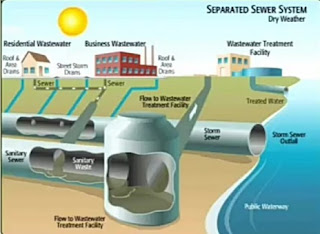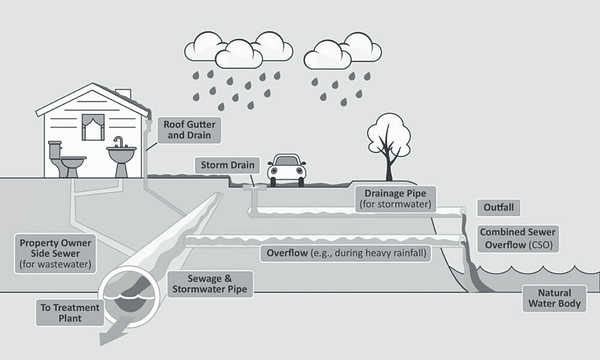Table of Contents
What is the Sewerage System?
Sewerage is the infrastructure that conveys sewerage, and surface runoff using a Sewer.
It encompasses components such as receiving drains, manholes, pumping stations, stored overflows, and screening chambers of the combined sewer or sanitary sewer.
Sewerage enters the entry sewerage treatment plant or at the point of discharge into the environment.
It is the system of pipes, Chambers, manholes, etc. that convey the sewerage and stormwater.
Types of Sewerage Systems
- Combined System
- Separate System
- Partially Separate System
Combined Sewerage System
In a combined system, the same sewer is intended to carry both the domestic sewage and industrial wastes as well as the surface and the stormwater flow.

Situation for Adoption
- Rainfall is even throughout the year.
- Both the sanitary sewage and the stormwater have to be pumped.
- The area to be severed is heavily built-up and space for laying pipes is not enough.
- Effective or quicker flows have to be provided.
- If the sewers are laid along with the overall development of the area, a combined system is preferred.
Advantages
- Rainwater keeps sewage fresh making it easier and more economical for treatment purposes.
- Dilution also helps, this being in itself a method of treatment.
- Automatic flushing is provided by water.
- This is the simplest method of collection and house plumbing economies.
Disadvantages
- The bigger size of the sewer would involve larger excavation.
- Overflowing under the worst conditions may endanger public health.
- The cost of pumping and treatment would increase due to the large quantity of sewage to be handled.
- The dry weather flow is a small amount of the total flow, the large size of the sewer would often result in causing silting up due to the low velocity of flow during the dry period of the year.
Separate System
In a separate system, the domestic sewage and industrial wastes are carried in one set of sewers whereas the storm and surface water are carried in another set of sewers.

Situation for Adoption
- Where rainfall is uneven.
- Sanitary sewage is to have one outlet and other outlets for storing or surface water are available.
- Sanitary sewage is to be pumped.
- Separate sewers must be placed deeper and the stormwater drains nearer the surface to economies excavation.
- If the ground has steep slopes, it is easier to convert stormwater through an open drain to the natural stream.
- The finance available are small but sanitary drainage is imperative.
- If the subsoil is hard, it is difficult and costlier to lay a combined sewer of large size.
- If the sewers are laid before the area is developed, it is preferable to adopt a separate system.
Advantages
- Being smaller in size, the sewers are economical. The surface water may be taken in open or closed conduits or drains at or near the surface and discharged at suitable outlets, thus greatly simplifying the design of sewers of stormwater drains.
- There is no risk of stream pollution as no storm overflows are to be provided.
- The quantity of sewage to be treated is small, and the disposal or treatment works can be economically designed.
- If the pumping of sewage at the treatment works is necessary, the pumping cost would be much less as there is no need to pump the stormwater.
Disadvantages
- Unless laid at a steep gradient, self-cleaning velocity in the sewer cannot be assured, and flushing must be done. This may prove unsatisfactory and expensive.
- Risk of encroachment by unauthorized rainwater collection and consequent overflows of sewage may be there.
- Double-house plumbing is another disadvantage. Two sewers or drains in a street leading to greater obstruction of traffic and repairs to any one of them are being carried out.
- The maintenance costs of two systems are greater than that of one.
Partially Separate System
A partially separate system is a modification of the separate system in which the separate sewer discharging domestic sewage and industrial wastes also contains a portion of the surface drained from back-paved yards and roofs of the house.

Why do we need a partially separate system?
It may raise that a combined system of sewerage has not been found quite suitable under tropical Indian conditions for the reasons outlined below.
- Concentrated and heavy rainfall during the monsoon period, which in most places lasts for only 3 to 4 months in a year. Thus, there is a considerable variation in the quantity of sewerage flow during the twelve months of the year.
- Inadequate amounts of wastewater reach the sewers because of a vast tract of intervening unsewered areas or due to other reasons so that the dry weather flow (DWF) is generally a tiny proportion of the total flow.
- The low economy and limited funds available.
- Difficulties in the operation and maintenance of the system due to inadequate supervision of less qualified staff. Local bodies in charge of the work usually do not pay much attention to keeping trained and skilled staff.
Because of the reasons described above, it has been found necessary in practice to have a compromise between the separate and combined system and to adopt as for as possible the partially combined or partially separate system of sewerage.
The underground sewer system carries, only the sanitary or domestic sewerage which may also be drained rainwater from the backyard and roofs of houses.
In contrast, the stormwater from the house front and the surface wash of streets and roads may separately discharge into a watercourse running near or to the same low-lying area at some farther distance.
Advantages
- It simplifies the drainage of the houses.
- It provides reasonable sizes of sewers and is economical.
- The rainwater provides some safeguard against silting in the sewer.
Disadvantages
- Low velocity during the dry period.
- Storm overflows may be found necessary.
If you found this article helpful, please be sure to share it with your friends.
Thanks!
Also, Read
Plumbing Traps – Purpose, 15 Types of Plumbing Traps
16 Types of Pipe Fittings in Plumbing Systems
Thanks for sharing this information, your blog is so helpful.